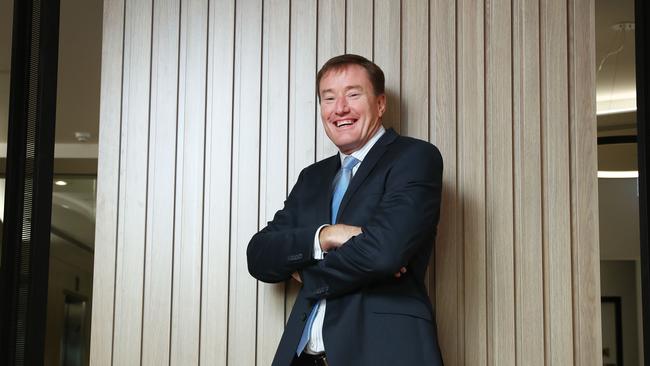Fast track of Squadron Energy’s Port Kembla import facility ‘would plug the gas supply gap’
Andrew Forrest’s Squadron Energy says its LNG import terminal at Port Kembla could be fast tracked to plug looming gas shortages on the eastern seaboard.

Andrew Forrest’s Squadron Energy says its LNG import terminal at Port Kembla could be fast tracked to plug looming gas shortages on the east coast, amid fears regular shortfalls are likely to emerge much earlier than initially anticipated.
Squadron’s Port Kembla Energy Terminal in the NSW Illawarra region is on track to become the nation’s first LNG import facility, with construction expected to be completed this quarter.
The facility is set to become operational in the winter of 2026 following the arrival of a floating storage and regasification unit (FSRU). However, Squadron Energy chief executive Rob Wheals said that could be brought forward a year to next year’s winter, but only with the support of state and federal governments.
“Based on market feedback, Squadron Energy’s focus is to bring the terminal into operation from 2026 to ensure the market remains well supplied, and to support customers ahead of the shortfalls predicted by AEMO,” Mr Wheals said.
“If there was a need to shore up security of supply for winter 2025, federal or state governments would need to act now, as time is running out to have the terminal ready in time.”

Once completed, the Port Kembla terminal will have the capacity to supply 500TJ a day into the east coast gas system – enough to meet all NSW’s gas needs on a peak day.
Squadron argues that the facility is the best short-term solution to plugging looming gas shortages on the east coast, despite it still looking for its first customers close to four years after construction began. Mr Wheals would not comment on how talks with potential customers were progressing.
Debate around the role of LNG imports in stabilising the domestic gas market is expected to escalate following last month’s dire warning from market operator AEMO about the state of the east coast market.
While AEMO is forecasting that structural gas shortages are likely to emerge from 2028, in a market “threat notice” issued to the industry on June 19, the market operator said the market had tightened substantially amid supply disruptions, low wind power generation and a winter cold snap that triggered a run on reserves. It warned that supplies in the east coast gas system “may be inadequate to meet demand”.
The notice suggested the threat of gas supplies running short extended from NSW to Victoria, South Australia, Tasmania and the ACT, and could last until September, sparking criticism from producers and gas users who blame years of inaction to unlock new gas development projects.
The Australian revealed in the days after the notice that AEMO also cautioned the industry that the largest supplier of gas storage on the east coast, Lochard Energy’s Iona facility in northeast Victoria, could run out of gas before the end of winter.
Squadron’s Port Kembla facility is one of several LNG import terminals under consideration, with Venice Energy courting investors for its $300m proposal at Port Adelaide and Viva Energy proposing a terminal for Geelong.

Rick Wilkinson, the chief executive of consultancy EnergyQuest, said AEMO’s warnings last month demonstrated the urgent need for LNG import terminals to stabilise the local market.
“The evidence is clear. A significant and increasing shortfall of gas is expected earlier than 2028 with seasonal and peak day swings. The sudden supply outage we saw last month confirms that shortfalls are real, and there is limited time to address this problem,” Mr Wilkinson said.
“If gas import terminals had been operational last month, the sudden supply shortfall that caused a spike in energy prices would likely not have happened.
Mr Wheals also argued LNG import terminals would put downward pressure on domestic gas prices. “LNG import terminals can supply cheaper gas from global markets when pricing is weak during the northern hemisphere summer, right as demand is peaking in the Australian winter,” he said.



To join the conversation, please log in. Don't have an account? Register
Join the conversation, you are commenting as Logout